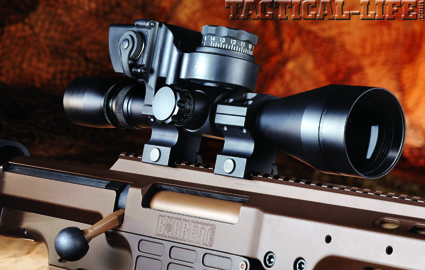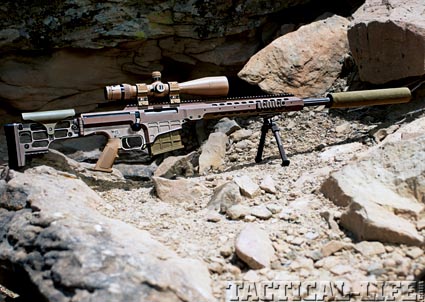Firearms manufacturers participating in U.S. Special Operations Command’s Precision Sniper Rifle (SOCOM’s PSR) trials approach design challenges from several different angles. Some designs are more complex and have more adjustments and features than required. At the other end of the spectrum is Barrett’s MRAD, a switch-barrel rifle that changes calibers to match its role.
When USSOCOM published their Performance Specifications for the PSR on December 16, 2009, nine companies stepped up to the challenge to design their sniper systems. Well versed in manufacturing the dependable M82A sniper system for the U.S. military, Barrett unveiled their MRAD (Multi-Role Adaptive Design) rifle to compete for a new government contract. But the program’s progress hasn’t proceeded smoothly. The PSR trials bogged down and came to a halt, only to restart again. On January 6, 2012, six manufacturers submitted rifles, ammunition and written proposals as the program breathed new life.
The MRAD rifle differentiates from some designs that are more elaborate and complicated. The beauty of the MRAD is its simplicity. Its monolithic design requires few moving parts or screws to replace. In other designs, there are as many as 30 screws that must be removed to change the barrel. To change calibers with the Barrett MRAD, you only have to remove two crossbolts with a simple hand tool, then remove and replace the barrel and bolt head. All of this is possible in less than two minutes. The MRAD’s user-modification capability in the field, on the fly, presents a valuable asset in either military or law enforcement roles.
Advertisement — Continue Reading Below
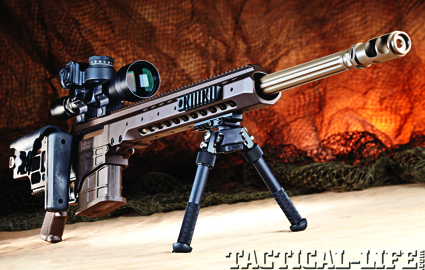
The MRAD tested for this article was fitted with a Leupold Mark 4 mil-dot scope. A BORS range-finding device is fitted to the top of the optic shown.
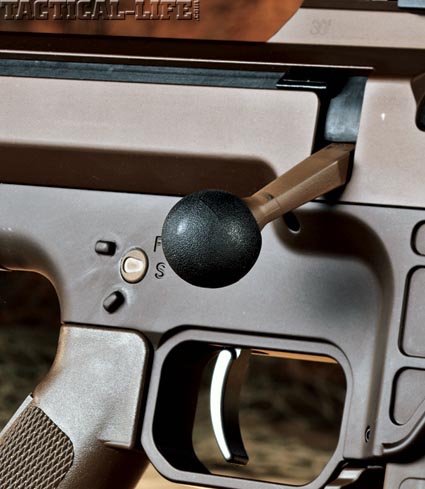
The enlarged bolt knob is easy to grasp and manipulate with gloved hands, and the MRAD’s action functions smoothly. Together, these features make for faster follow-up shots.
Precision Sniper Rifle
Over the last year, from what I’ve seen of the MRAD precision weapon system, Barrett has a real winner. The MRAD passed the first stage of the military’s firearms trial in April 2010, which acknowledged the MRAD’s performance capabilities.
Advertisement — Continue Reading Below
The MRAD was specifically developed to meet the needs of the PSR program. The PSR encompasses a set of USSOCOM requirements. The purpose of a PSR is to enable snipers to kill enemy personnel, take out enemy positions, and disable non-technical vehicles mounted with crew-served weapons out to 1,500 meters. The PSR’s projectile must be capable of defeating Level III body armor out to 900 meters, too. All of these requirements point to the .338 Lapua Mag loaded with 250-grain or heavier bullets.
Since a weapon is carried a lot more than fired, other PSR parameters encompass length and weight. Magazine capacity and the ability to mount night-vision devices and other accessories are important, too.
The PSR’s Performance Specifications spell out the required components of a sniper system. Each unit includes a rifle, ten magazines, sound suppressor including a shroud to cut down on mirage, an operator manual, sling, cleaning kit, bipod, drag bag and a hard carrying case to hold it all.
Advertisement — Continue Reading Below

The folding stock locks over the bolt handle to keep it secure during rough handling, like paratrooper jump operations. STEVE WOODS PHOTO
Gun Details
USSOCOM specifies that a PSR must be no longer than 50 inches fully extended, without a suppressor, with the ideal length set at 40 inches overall. With the stock folded, the maximum length is 40 inches, with 36 inches set as the objective. The maximum qualifying PSR weight is 18 pounds equipped with a Mil-Std-1913 rail and an empty 10-round magazine. Extra points are scored in the competition by keeping the weight under 13 pounds. Barrett’s first MRAD submitted for the PSR trial was fitted with a 24.5-inch barrel and weighed 14.8 pounds without an optic.
The MRAD submitted for the PSR trial in early 2011 was fitted with a fluted 24.5-inch barrel chambered in .338 Lapua Mag. One of the MRADs tested for this article was outfitted identically to the rifles initially submitted to USSOCOM. Over the past year, I tested several Barrett firearms. On nearly every outing, Barrett brought an MRAD along so we could put rounds downrange. All together, I fired more than 200 rounds of .338 Lapua Mag, and nearly that much .308 ammunition with the barrel swapped out.
Advertisement — Continue Reading Below
The first .338 Lapua Mag MRADs sold to the commercial and law enforcement markets sported 20- or 24-inch barrels. After numerous factory tours, I learned that during the experimental stages of development Barrett engineers built .338 barrels from 18 to 27 inches long. They learned that certain lengths were optimal. “We found that as you go down from 27 to 24.5 inches, you don’t lose very much velocity,” Barrett said, “but going down to 22 inches, you lose a significant amount. To maintain the supersonic performance at 1,500 meters, you need the 24-inch barrel length.”
The 24.5-inch barrel is mil-spec chrome-moly-vanadium with a 1-in-10-inch twist rate for the .338 Lapua Mag. Barrett also introduced a 20-inch stainless .338 Lapua Mag barrel in early 2011 with a 1-in-9.35-inch twist rate.
According to the USSOCOM specifications for a PSR, the “rifle shall incorporate an adjustable stock for length-of-pull adjustments, and an adjustable cheekpiece that shall provide adequate adjustment to allow for eye alignment with optics. The PSR rifle shall accommodate a quick method to decrease the overall length of the stock for tactical carry/enhanced portability without separating the action from the stock.” Barrett accomplishes these thresholds with the MRAD by the use of a monolithic chassis with a 30-MOA Mil-Std-1913 rail that measures 21.75 inches long. That’s plenty of rail length to mount an in-line night-vision device forward of a daylight scope.
Advertisement — Continue Reading Below
The MRAD has two configurable 4-inch Picatinny rails and an 8-inch rail, all of which can be mounted along the 3, 6 and 9 o’clock surfaces on the forward part of the upper receiver. The bottom of the buttstock also has a Picatinny rail for mounting a monopod.
The MRAD’s stock is foldable for enhanced portability yet locks in as solid as a fixed-stock rifle. This creates a rigid platform for consistent firing. When folded, the stock latches around the bolt handle for added security during transport. Because the stock folds to the bolt-handle side of the action, the rifle is the same width overall, folded or extended. Made of a temperature-resistant polymer, an adjustable cheekpiece also offers a consistent rifle-to-user contact point. Barrett’s MRAD length of pull can be set to five different positions with the push of a single button.
“An advantage to the MRAD’s folding stock is that it locks the bolt handle down, which secures the gun and keeps dirt out of the bolt,” Lynch said. “It also reduces the width of the weapon with the stock closed. With sniper weapons that have folding stocks that fold to the other side, you have the width of the bolt handle plus the receiver and the stock. All that’s required to deploy the stock is to pull it open. There’s a polymer-coated spring that is used as a keeper to capture the bolt knob to hold the folded stock in place.” The stock also has integral sling bushings in two positions to offer the user different location choices.
Advertisement — Continue Reading Below
Multi-Caliber
One of the objectives of the PSR is caliber modularity. The .338 Lapua Mag is the most widely used cartridges by militaries around the world that meet the PSR’s cartridge ballistic requirements. Currently, the .300 Win Mag is in use with all of the M24s, and the XM2010, which is a conversion of the M24 from .308. The military also wants to retain the ability to shoot 7.62mm NATO for cost-efficient training.
The MRAD rifle’s user-changeable barrel system is just one example of this hard-working gun’s modularity. Its design paves the way for future caliber interchangeability, with barrels chambered in .300 Win Mag and 7.62mm NATO.
Barrel life is expected to be more than 3,000 rounds for the .338 MRAD. “We have a prototype that’s had 2,500 rounds through it and it’s still a sub-MOA gun,” Lynch added. And the rifle is designed for abuse. In fact, the MRAD is designed to survive in free-fall parachute operations without a case.
Advertisement — Continue Reading Below
The finish on the stock is 7000-series mil-spec hardcoat anodized aluminum in Barrett Multi-Role brown. A proprietary rust preventative coats all steel components. The pistol grip is a standard A2 grip. The bolt assembly slides inside a polymer sleeve, which works well without lube.
The MRAD also boasts Barrett’s new easily accessed trigger module. Adjustment, maintenance and replacement are simple, straightforward exercises. This is a match-grade trigger that is adjustable from 3 to 5 pounds of let-off. “In an earlier military trial, a part of the competition landed a helicopter 10 feet from one of our 98Bs,” Lynch recalled. “There was so much dirt in the trigger mechanism that the sear wouldn’t drop. We learned from that experience and designed the new trigger for the MRAD. We’ve filled the MRAD with so much dirt that you couldn’t close the bolt, shook it out and the trigger still worked without fail.” The trigger on the first MRAD I fired was 3 pounds, but is adjustable from 2.5 to 5 pounds. I didn’t weigh the trigger pulls on subsequent rifles, but they felt relatively similar.
The MRAD’s safety is an AR-style thumb lever that can be quickly moved from one side to the other. For shooters who prefer to shoot thumb-forward instead of wrapped around the pistol grip, it’s an easy change to move the safety from one side to the other. An ambidextrous magazine release, located between the front of the triggerguard and the magazine well, drops empty magazines free while retaining the firing hand’s finger grip on the pistol grip.
Advertisement — Continue Reading Below
The gun submitted for the PSR trials, and the one I shot first, is one of the last that was built with a particular muzzle brake that’s designed for a Gemtech titanium suppressor. Newer versions wear the proven and effective 98B muzzle brake because it will allow the operator to choose between more suppressor makes, such as ones made by SureFire, Thunder Beast Arms and others.
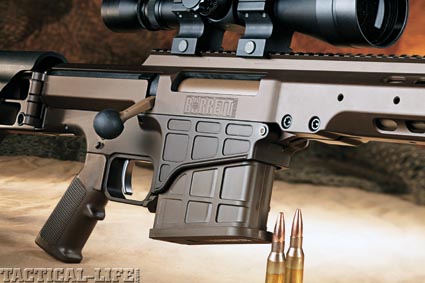
The .338 MRAD’s mags will hold 10 rounds of this powerhouse cartridge.
Range Time
The best ballistic performance from the .338 Lapua is achieved with the 300-grain Scenar bullets, so that’s what was tested during my first time behind an MRAD. After firing 10 rounds across a Shooting Chrony chronograph, I set up a 100-yard target and fired four 5-shot groups. All shooting was from a concrete bench using a gun-mounted bipod and a sand sock rear bag. The best group measured 1 inch. The other groups had called flyers that opened them up beyond MOA, but the other four shots in each group formed nice little clusters that averaged a half-inch. Moving out to 300 yards, the MRAD really shined. I fired three sub-MOA groups, with the best measuring 1.59 inches.
A few weeks later, we went to my farm and spent the afternoon shooting a Barrett M107LW and another MRAD in .338 at 500 yards from a prone position. My five-shot groups averaged just under 5 inches, with the best measuring 3.25 inches. A few other days, I maintained sub-MOA groups, but I wasn’t able to better my earlier smallest 500-yard group.
A few weeks ago, I took yet another MRAD to Horse Branch Farm to punch some more paper. This time, I had a 24.5-inch 7.62mm NATO barrel installed. I fired a couple of match loads at 100 yards from a bench using an Atlas bipod. After firing 100 rounds downrange, my worst five-shot group with either load was in the high 0.80-inch range. Winchester’s 168-grain match load averaged 0.63 inches, with the best group measuring 0.34 inches. Federal’s 168-grain Gold Medal Match averaged 0.61 inches, and the smallest group was 0.29 inches.
Final Notes
No matter the outcome of the PSR trials, Barrett’s MRAD is a proven, ultra-range tack driver with power of a sledgehammer. It will find popularity in military, law enforcement and sporting circles. I’m not quite sure if the .300 Win Mag will find much traction outside of military circles, since a .308 and a .338 Lapua Mag should cover the spectrum of sniping needs, but the MRAD has all the bases covered. The first .338 Lapua Mag models started shipping in March of last year, with the 7.62mm NATO and the .300 Win Mag barrels becoming available this year. Find out more by calling 615-896-2938 or visiting barrett.net.
